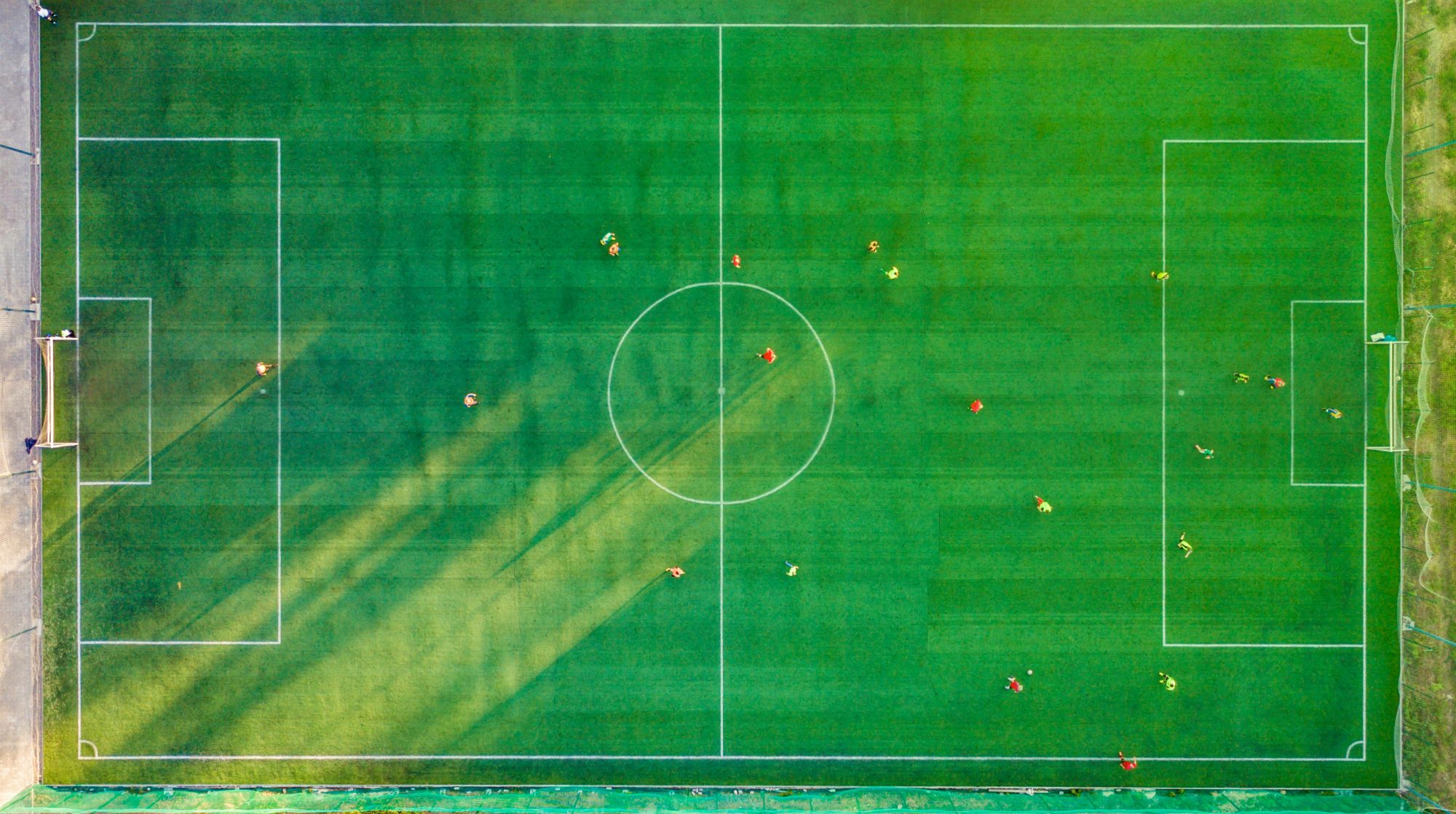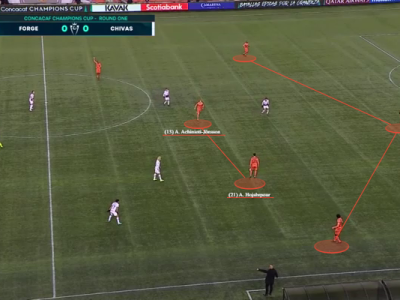Barcelona have started the season off unbeaten, but it hasn’t been the two most convincing performances from Xavi Hernandez‘s team, as they continue to adjust to the array of midfield talent they have at their disposal. Here is Game of Numbers #25, starting with Barcelona’s use of Frenkie de Jong as a centre-back.
BARCA’S BUILD & DE JONG AT CENTRE-BACK

FC Barcelona have too many midfielders! So many midfielders that they are playing one of their midfielders as a centre-back. Meanwhile, Xavi’s old coach Pep Guardiola is playing his centre-backs in central midfield! Do they need to talk to each other and sort something out?
Embed from Getty ImagesAgainst Cádiz, the possession-heavy Barcelona dominated the play and eventually walked away with a 2-0 victory after two late goals. But the chinks in the armour still clearly need to be sorted out. When Xavi’s side started the season against Girona, they played with real centre-backs. But they lost Ronald Araujo to injury and needed a solution for their second fixture. Frenkie de Jong and İlkay Gündoğan were essentially playing the same position against Girona anyway, so in the quest to fit all of his midfielders together, Frenkie de Jong dropped into the defensive line.
Embed from Getty ImagesThis is something the Dutchman has done before. He’s dropped into a back-three in-possession throughout his career, but also started a few matches as either the middle or left-sided centre-back in a three. Against Cádiz, it provided some intrigue as to how Barca could play out from the back.

Initial builds started with both of their fullbacks high in a 2+4 shape (+ ter Stegen), utilizing narrowness of their central quartet and width from the fullbacks to create the tiniest of openings through the centre of the pitch. They wanted to take advantage of these tiny spaces, and go against the screams of many youth coaches asking their teams not to play in front of the net. Ter Stegen would then open up the game with a slice through the middle, where the likes of Gavi and Pedri could combine higher up the pitch.

The distance between the low slotting of Gündoğan + Romeu and the higher positions of Pedri and Gavi would allow them the space to do this, and ter Stegen is one of the best keepers around in playing these passes out from the back.

As far as De Jong goes, his starting position allowed opportunities to carry the ball out from the back and break pressure on his own. The 26-year-old is an outstanding ball carrier, and this is a great asset to have in players involved in the earliest phases of builds. However, when he carried forward, it meant that İlkay Gündoğan had to stay.

Gündoğan is fantastic in the final third, and we’d all like to see him pushed further forward to get the best out of that Barca attack. He sees spaces that other players simply don’t see, and this is exactly how he carved open the Cádiz defense for Barca’s first of the match.

De Jong can be quite a creative and intelligent wrecking force as well, and this complicates matters for him by having him play as a centre-back. It means that Andreas Christensen then has much in the way of work to do in covering for his position, since Gündoğan lacks the same leg speed.

Oriol Romeu should be the man trusted to stay back, but he was also allowed to push forward rather than holding as a strict ‘6’. Romeu can be a great ‘Midfield Destroyer’. But he’s nowhere near as classy as those other four central midfield options. So in future matches, I would much prefer to see him be the one to either step into centre-back if needed, or hold a stricter ‘6’ position in their rest-defense.

This proved to be an issue for La Blaugrana in transition, particularly after their set-pieces. They played with just Frenkie de Jong and Alejandro Balde holding down the gauntlet, completely exposing themselves to fast-breaks.
Operating in a front-two, Cádiz could then go toe-to-toe with the Barca men at the back, where a massive separation occurred between them and the next line of defense.

While Christensen and Romeu are the big and burly type of players you’d love to have in the box in set-pieces, you also need to consider rest-defense when building out set-piece plans. Frenkie de Jong is not the most ideal player to have in those situations, even if from simply just lacking the same defensive exposure.
So as Barcelona progress through the season and look to challenge for another league title, a question still remains about how they are to get the best out of their midfield talent.
BRIGHTON IN TRANSITION VS. WOLVES
Embed from Getty ImagesSome of the dialogue surrounding football serves to create a dichotomy between counter attacking teams and those that favour possession. The assumption is that you can only be one or the other. That couldn’t be further from the truth. In fact, many of the best teams on the break also happen to be some of the highest in possession. That’s where many of Manchester United’s best moments have come since the departure of Sir Alex Ferguson, it’s where Dortmund so often rip teams apart, and Roberto De Zerbi’s Brighton are now one of the best around at attacking transitions.
Embed from Getty ImagesBrighton scored two of their four goals against Wolves in a 4-1 win on the break, with the combination of Enciso and March combining to perfection. So what exactly did they do to be so effective on the break?
Embed from Getty ImagesFor starters, when Brighton win possession, they are always looking for the quickest route forward. This is essential in counter attacking transitions, ensuring the opposition have minimal time to get back into position.

Often we’ve spoken about verticality in helping to ease that matter all the more, as forward movement in a straight line will naturally speed the momentum. However, this has to be in relation to the space available in the moment. In looking at both of the moments, this is where Brighton excelled with their first set of decisions.
On the first of Enciso’s incisive assists, Billy Gilmour recognizes Nelson Semedo;’s high position in attack, and immediately hits the space available in his vacated wide right position. Enciso hangs out in that area to take full advantage, and can then drive forward in acres of space.

Similarly, on the second of Enciso’s incisive assists, Danny Welbeck takes advantage of Mario Lemina’s advanced position to drive forward through the centre and hang onto the ball a little while longer, thus pushing the defensive line back. But he does not just dribble in a straight line, straight at the defense. Instead, he dribbles toward the space available.

Now it’s all about the movement ahead.
On that first Enciso assist, March can see the gap in between defenders the entire time, and only has eyes for goal. He makes his way through the gap as quickly as he can, and Enciso’s pass is timed to perfection.

But the second goal is more intricate. March again starts as the highest player, and he bursts through the centre. Enciso compliments March’s movement by shifting in the opposite direction, seeking the space out wide to stretch the field.

In doing so, he’ll open up more space for March to move into, more space for Welbeck to dribble into, and more space for himself to receive a pass (as the opposition will want to compact the centre). When he picks up the ball just outside of the eighteen, there’s only ever going to be one result.

March again plays his part, sprinting down the blindside of the defender and outpacing Semedo to the pass.
Embed from Getty ImagesNow in spite of their brilliance in attacking transitions, Brighton still have a few things to sort out going the other way. Their involvement of fullbacks either inverted or high up the pitch means that their wide areas will be targeted in transition. A 2+3 naturally means that teams will be looking to hit the wide areas in transition. This is where both Wolves and Luton could have hurt the Seagulls.

James Milner is not the quickest of right-backs in the Premier League, and he’ll need to be paired with someone exceptional at covering spaces in behind. Adam Webster or Lewis Dunk certainly fit that billing, but the Seagulls no longer have the transitional magnificence of Moisés Caicedo or Alexis Mac Allister. They’ll need to ensure they get the balance right in midfield, and quickly close those gaps when they open in defensive transitions.

If they can do that, Roberto De Zerbi’s team will certainly be in for another shout at a top six finish. The victories have been that commanding, and the performances have been that brilliant.
MORE TO FOLLOW NEXT WEEK!
Be sure to check back soon as we analyze more matches and performances across the next round of fixtures! Plus be sure to see the previous edition below.
-> Game of Numbers #24 – Bellingham at the top of the diamond
YOU MIGHT ALSO ENJOY…
Game of Numbers #38 – Alejandro Garnacho’s intensity & awareness
It’s amazing to think that Alejandro Garnacho is only 19 years of age. Sometimes, you can see the rawness in his game. The facets that still need to be carefully developed. But as he ages, let’s hope he never loses his tenacity. His hunger for more. His appetite to win at all costs, even when…
Game of Numbers #37 – Forge FC’s use of centre-backs in midfield like Manchester City
For the unfamiliar, Forge FC are the Manchester City of the Canadian Premier League. They play a possession-based 4-3-3, stacked with ball-savvy savants, and a culture that embodies winning. The Canadian Premier League’s been around since 2019 now. Forge have won the Playoffs in four of the five seasons, and lost the final in the…
Game of Numbers #36 – Role Changes for Dejan Kulusevski & Konrad Laimer
One thing is for certain. Spurs have not been the same since injury to James Maddison. Spurs were flying high with no signs of slowing down at the start of the season. But injuries across the squad have since stunted their progress and made for a more difficult second half of the first half to…





3 thoughts on “Game of Numbers #25 – Barca’s midfield diamond & Frenkie de Jong in defense”